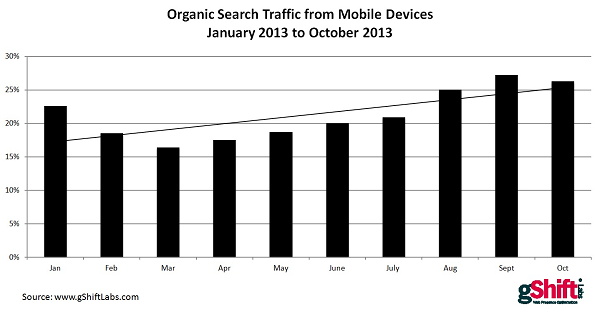Google’s recent Hummingbird algorithm and the arrival of KitKat are forcing agencies and brands to stretch their search marketing minds and strategies even further – for the better.
More focus on meaningful content and mobile engagement with content translates into a need for longer-term SEO and content marketing commitments. Clearly the days of quick wins and overnight successes in SEO are indeed an era that is well behind us.
In “Time for a New Definition of SEO“, many readers commented with their own insights and opinions about the requirement for a new definition of SEO. The following concept seems to be prevalent:
SEO is the long-term process of enhancing a brand’s opportunity for discoverability in search and social, throughout the prospect’s buying cycle and across any device.
Understanding searcher behavior by channel, intent by geography, and engagement by content asset throughout the buying cycle is key to a brand’s web presence reputation.
Mobile Usage is Forcing a Shift of Search Strategies
It is projected that the number of mobile devices on this planet will surpass the population of the world in the near future. As it stands, according to data available on Wikipedia, there are 6.8 billion mobile devices used by 7 billion people.
Emerging economies such as the Philippines, Thailand and Malaysia already have more mobile devices than people. Other countries that exceed the 100 percent threshold include the United States, the UK, France, and Italy.
Marketers and brand leaders need to consider how their brand content is discovered and engaged with by searchers on a mobile device compared to a desktop. For example, on a mobile device geography is more likely taken into consideration.
Additionally, a conversational or voice search is a more likely occurrence on a mobile device versus a desktop. Think about the behavior difference between the two searches. On your desktop you may type “flower shops in New York”, while on your mobile device you’d likely speak into your phone and say, “I’m looking for a flower shop in New York.”
This behavioral change indicates that consideration needs to be given to:
- The keywords used.
- How the content is consumed.
- Who is searching for and consuming the content.
- Their stage in the buying cycle.
- Conversion rate differences.
“Mobile is probably growing faster than anyone in the room expects,” said Google’s Distinguished Engineer Matt Cutts at SES San Francisco in September. “Mobile traffic to Google will surpass desktop traffic to Google pretty soon – not in weeks or a few months, but soon.”
So it isn’t a surprise Google is focusing its algorithm changes on ensuring relevant search results are returned when a search is performed from a mobile device.
Mobile Organic Search Trends
RKG published data recently showing the percentage share of organic search visits across Google, Yahoo, and Bing quarterly from Q2 2012 to Q2 2013. The data essentially shows one quarter of all organic search visits comes from mobile devices, and this trend is increasing.
My company is also tracking mobile organic search traffic trends. Across 6,000 monitored web presences, gShift’s data shows the same trend in increasing mobile traffic from January 2013 to October 2013. The amount of organic search traffic from mobile devices was registered at 27 percent and 26 percent in September and October respectively.

Note: this data isn’t yet segmented by geography or business type.
Here are five ways brands and agencies can start capitalizing on this mobile trend in search.
1. Your Current SEO or Content Marketing Strategies
If a current SEO and content marketing strategy is being executed on, ensure mobility has been taken into consideration for keyword research and conversion measurement.
If you’re thinking of starting an SEO or content marketing strategy, be sure to ask the service provider how they are going to account for the trends in mobile organic search behavior, and how they are going to measure discoverability and engagement of content on a desktop versus a mobile device.
2. Expand Your Keyword Research and Tracking
“(Not provided)” and “(not set)” have made keyword performance tracking much more challenging. This, combined with the fact that a searcher’s behavior varies greatly depending on whether their search is executed from a mobile device (typed or spoken) or a desktop device (typed or spoken), means more keywords need to be monitored for discoverability and position change to understand which content asset is potentially being discovered for a grouping of similar keywords.
Groupings of like keywords are key. For example:
- Flower shop
- Flower store
- Flower shop New York
- Flower store New York
- Flower shop in New York
- Flower store in New York
- I am looking for a flower shop
- I am looking for a flower store
- I am looking for a flower shop in New York
- I am looking for a flower store in New York
3. Track Mobile Segments in Google Analytics
Tracking mobile segments in Google Analytics is key to understanding the actions your visitors are taking from their mobile device and their engagement with your content and your brand and how it differs from a desktop.
“Mobile Traffic”, “Mobile and Tablet Traffic” and “Tablet and Desktop Traffic” are built-in segments you can select in Google Analytics. To analyze the behavior of only desktop users on your website, you will need to create a new segment:
- Click on the arrow at the top left of your Google Analytics Overview screen to open the Segment Builder.
- Click on the “+ Create New Segment” button at the top left.
- Click on “Technology” in the left menu bar.
- Scroll down to “Device Category” and select “exactly matches” and “desktop”.
- Enter the “Segment Name” at the top (e.g., Desktop Traffic).
- Click Save.
Now you can select both the mobile and the desktop segments to gain insight into the conversion rate differences between visitors from each source (e.g., Conversion of Time on Page or Number of Pages Visited), and take action to improve your content accordingly.
4. Page-Level and Content-Level Web Presence Analytics are Key
Reporting on the engagement, performance, and discoverability of content, and understanding where optimization opportunities exist, require content-level or web page-level analytics. These metrics include page-specific backlinks, social signals, and conversions.
Again, select the Mobile Traffic and Desktop Traffic segments discussed above, determine if your content is converting higher on mobile or desktop, then seek to understand why.
Track keyword position at the content level to gain insight into keywords the content may be ranking for, and identify opportunities to improve that content for further optimization, discoverability, and engagement.
5. Human Factors of Optimization

All too often we forget to stop looking at the data and metrics and simply attempt to engage with the brand as a human being. Human factors testing across devices is key.
You can take your testing a step further by setting up a focus group and watch how people interact with the brand’s web presence from different devices, and what keywords they are using to discover the brand.

Thanks for sharing an good information...
ReplyDeleteProject Centers in Chennai
Thanks for sharing useful information for us.I really enjoyed reading your blog, you have lots of great content.Please visit here:
ReplyDeletehttp://jaipurpackersandmovers.in/
http://jaipurpackersandmovers.in/packers-and-movers-alwar
http://jaipurpackersandmovers.in/packers-and-movers-ajmer
We are expert in Handling, Movers And Packers Jaipur and Packing & Shifting of Household Goods, Office goods, Commercial Equipment and Car, Logistics and Transportation.